Centenary of the Holywood and District War Memorial
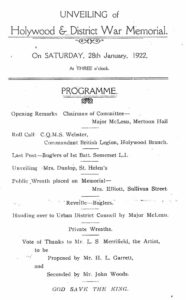
Wreath Ceremony 1922
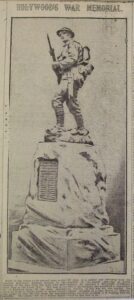
Model (Belfast Telegraph Aug 1919)
On Saturday 28th January 1922, the Holywood & District War Memorial was unveiled.
The decision to proceed with the erection of a war memorial to commemorate fatalities from Holywood and District was taken at the Town Hall on 15th August 1919. Mr Leonard Stanford Merrifield of Chelsea provided a model of the memorial. In 1919, 150 subscribers had promised £725 and it was thought that the total cost would be £900, which equates to £47,500 in current terms.
The memorial was erected on a parcel of open ground between Holywood Railway Station and Holywood Orange Hall. The plot had been purchased for this purpose by Mr David Alfred Fee JP, who donated the plot to Holywood Urban District Council.

Site Preparation (Belfast Telegraph Nov 1921)
Site preparation work commenced in November 1921. The rugged Portland Stone base of the memorial was nine feet and six inches tall and the bronze statue of the soldier in full war kit in “On Guard” position was six feet high.
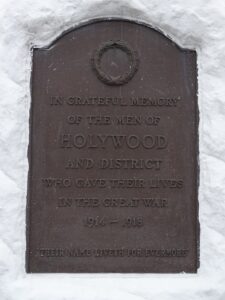
Dedication Panel
Company Quartermaster Sergeant Wilmot Webster, Commandant of the Holywood Branch British Legion, read out the names of the 109 men commemorated on the memorial, the announcement of each name being followed by a muffled drumbeat. Wilmot Webster of High Street in Holywood was a 42-year-old married man with three children when he enlisted with the 6th Battalion Connaught Rangers on 14th November 1914. He held the rank of Acting Quartermaster Sergeant when he was deployed to France with 16th (Irish) Division in December 1915.

Extra Name (S Patterson)
He was serving with the Labour Corps when he was transferred to the Class Z Army Reserve on 10th April 1919. He subsequently received a pension for deafness attributable to his war service and rheumatism and arthritis aggravated by war service. He died on 1st January 1926, aged 52, and is buried in Holywood Cemetery.
An additional name was added in 2011. Samuel Potter, who served as Patterson, was killed in action on 14th September 1914 during the Battle of Aisne whilst serving with 2nd Battalion Connaught Rangers. Amongst the names commemorated are a recipient of the Victoria Cross, three men awarded the Military Cross and two men awarded the Military Medal.
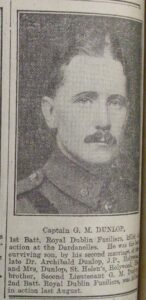
George Malcolm Dunlop
The memorial was unveiled by Mrs Bessie Dunlop of St Helen’s in Holywood, the widow of Dr Archibald Dunlop. She said, “I feel honoured in being asked to unveil this beautiful and striking monument, erected to the memory of our fellow-townsmen, who gave their lived for King and Country. I am one of those who suffered a double loss among them. I think my eldest son was, of those we commemorate today, the very first to fall.”
John Gunning Moore Dunlop was born on 14 December 1885 and received his commission from Cambridge University Officers Training Corps in September 1910. He was gazetted to the Special Reserve of Officers for the Royal Dublin Fusiliers in June 1911. He was deployed to France with 2nd Battalion Royal Dublin Fusiliers, disembarking at Boulogne on 22nd August 1914. He was Killed in Action five days later near Clary during the Battle of Mons at the age of 28.
George Malcolm Dunlop was born on 13th January 1889, received a commission with the Royal Dublin Fusiliers in 1909, and held the rank of Captain in December 1914. He was killed in action with 1st Battalion at the age of 26 during the calamitous landing at Cape Helles on the Gallipoli Peninsula on 25th April 1915.

Mary Elliott laying Holywood wreath
The Public Wreath was laid by Mrs Mary Elliott of Sullivan Street who lost three sons in the Great War.
Private William Robert Elliott was serving with 2nd Battalion Royal Inniskilling Fusiliers when he was killed on 26th August 1914 during the retreat from Mons at the age of 32.
Lance Corporal Joshua Elliott was serving with 13th Battalion Royal Irish Rifles when he was killed by shell-fire during heavy enemy bombardment on 4th August 1917, at the age of 30.
Sergeant Francis James Elliott was serving with 2n Battalion Royal Irish Rifles when he died of wounds on 7th August 1917 at the age of 28.
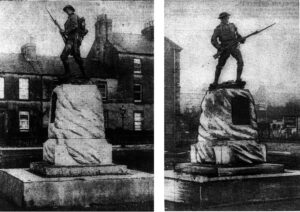
Holywood War Memorial (Belfast Weekly Telegraph, Feb 1922)
The Dunlop brothers and the Elliott brothers are also commemorated on the memorial tablet in Holywood Parish Church.
David Alfred Fee, Chairman of Holywood Urban District, said,
“I have the melancholy pleasure of accepting, on their behalf, as custodians of the ratepayers, the statue just now unveiled, which will remind future generations of the heroic deeds of the gallant sons of Ulster who went out voluntarily in response to their country’s call to fight in the spirit of their forefathers for liberty and freedom”.
David Alexander Fee was to suffer personal loss in the Second World War when his son, Lieutenant Thomas Hugh Cecil Hickland Fee, Royal Naval Reserve, was Killed in Action on 23rd November 1939, aged 28, whilst serving on HMS Rawalpindi.

HMS Rawalpindi

Holywood Trophy Gun (Larne Times, July 1924)
From July 1924, the memorial was flanked by two German guns that had been awarded to Holywood as war trophies.
From examining old newspaper images and postcards, the memorial has been moved twice in the past 100 years. It was originally position in the middle of the square closer to the Orange Hall and protected from traffic by railings. Later, four sturdy stone bases were set in place to support light fittings. Later still, the memorial was moved closer to the shoreline and there was talk of turning it around so that the people attending on Remembrance Sunday would not be facing the back of the memorial.

Holywood War Memorial
There was local opposition to this as the soldier was deemed to be protecting the town from seaborne attack. In recent years, the memorial was moved to its current position and the rugged Portland Stone base replaced by a dressed stone base.
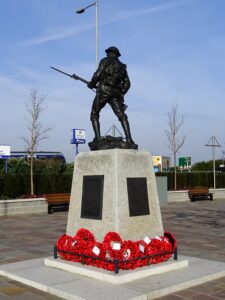
Holywood War Memorial
They shall grow not old, as we that are left grow old:
Age shall not weary them, nor the years condemn.
At the going down of the sun and in the morning
We will remember them.
Nigel Henderson
History Hub Ulster Researcher

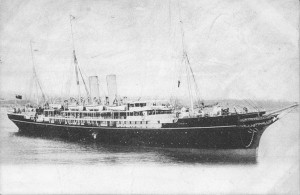 HMS Viknor – an armed merchantman, struck a mine off Tory Island on 13 January 1915.
HMS Viknor – an armed merchantman, struck a mine off Tory Island on 13 January 1915.